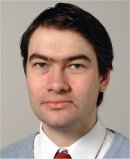|
Plenary
Lecture
Cross-Talk of Hypoxic and Map Kinase-Dependent
Signalling Pathways in Toll-Like Receptor (TLR)-Mediated
Inflammatory Reactions

Dr. Vadim Sumbayev
Medway School of Pharmacy
University of Kent
Anson Building, Central Avenue
Chatham Maritime, Kent ME4 4TB
United Kingdom
E-mail:
V.Sumbayev@kent.ac.uk
Abstract: TLRs are the key
pattern recognition receptors that
lie at the core of resistance to
disease, initiating most of the
phenomena that occur in the course
of innate immune reactions. In our
studies we found that ligand-induced
TLR4 (cell membrane-associated
receptor which recognises LPS of
Gram-negative bacteria) signalling
triggers cross-talk of ASK1
downstream pathway and HIF-1alpha
in THP-1 human myeloid cells. Both
pathways were activated via redox-dependent
mechanism associated with tyrosine
kinase/phospholipase
C-1gamma-mediated activation of
protein kinase C alpha/beta. The
latter activated NADPH oxidase
and, therefore, the production of
ROS which up-regulate both
HIF-1alpha and ASK1. ASK1
contributes to the stabilisation
of HIF-1alpha protein via
activation of p38 MAP kinase which
directly phosphorylates
HIF-1alpha. Knockdown of
HIF-1alpha in THP-1 cells with
siRNA suggested that this protein
supports TLR4-dependent production
of pro-inflammatory cytokines by
protecting the cells against
depletion of ATP and therefore
against death. Ligand-induced
activation of TLR7/8 (endosomal
receptors which recognise viral
ssRNA) leads to the accumulation
of HIF-1alpha protein in THP-1
human myeloid macrophages via
redox- and reactive nitrogen
species-dependent mechanisms. ASK1
and its downstream MAP kinases as
well as PI3-kinase are not
involved in TLR7/8-mediated
HIF-1alpha accumulation.
Experiments with HIF-1alpha
knockdown THP-1 cells have clearly
demonstrated that this protein
is?important for the protection of
these cells against TLR7/8-induced
depletion of ATP and for
production of the pro-inflammatory
cytokines. Therefore
membrane-associated and endosomal
TLRs use differential mechanisms
of activation of HIF-1alpha but
the function of the protein is
similar in both cases.
Brief Biography of the Speaker:
I achieved my PhD degree in 1999
from the Palladin Institute of
Biochemistry, National Academy of
Science of the Ukraine. After
graduating, I worked as Assistant,
then Associate, Professor at the
Department of Biochemistry,
Mechnikov Odessa National
University in the Ukraine. Then I
moved to Germany where I received
an Alexander von Humboldt research
fellowship and worked as a
Humboldt fellow in the Institute
for Cell Biology, University of
Kaiserslautern. Upon complete of
my fellowship, I spent three years
in Denmark at the University of
Aarhus, working as Assistant
Professor at the Department of
Molecular Biology at the
Interdisciplinary Nanoscience
Centre. In December 2006, I joined
the Medway School of Pharmacy,
University of Kent as a Lecturer
in Biochemistry where I have
established my research group.
|
